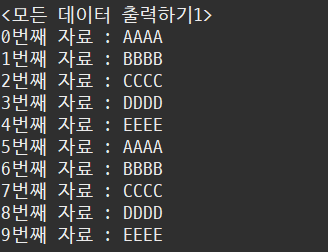1. ArrayList
A. 객체 생성
System.out.println("<객체 생성>");
ArrayList list1 = new ArrayList();
System.out.println("처음 크기 : " + list1.size());
B. 데이터 추가하기
System.out.println("<데이터 추가하기>");
list1.add("aaa");
list1.add("bbb");
list1.add(123);
list1.add('k');
list1.add(true);
list1.add(123.45);
System.out.println("list1 ==> " + list1);
System.out.println("size ==> " + list1.size());
C. 데이터 꺼내오기
System.out.println("<데이터 꺼내오기>");
System.out.println("1번째 자료 : " + list1.get(1));
D. 데이터 삭제하기
System.out.println("<데이터 끼워넣기>");
list1.add(3, "zzz");
System.out.println("list1 => " + list1);
E. 데이터 변경하기
System.out.println("<데이터 변경하기>");
String sTemp = (String)list1.set(3, "yyy");
System.out.println("list1 => " + list1);
System.out.println("sTemp => " + sTemp);
F. 데이터 삭제하기
System.out.println("<데이터 삭제하기>");
list1.remove(3);
System.out.println("3번째 자료 삭제 후 list1 => " + list1);
list1.remove("bbb");
System.out.println("bbb 자료 삭제 후 list1 => " + list1);
3-1. 제네릭 사용하기
A. 객체 생성
System.out.println("<객체 생성>");
ArrayList<String> list2 = new ArrayList<>();
System.out.println("처음 크기 : " + list2.size());
B. 데이터 추가하기
System.out.println("<데이터 추가하기>");
list2.add("AAAA");
list2.add("BBBB");
list2.add("CCCC");
list2.add("DDDD");
list2.add("EEEE");
System.out.println("<리스트의 모든 데이터 출력하기1>");
for(int i = 0; i < list2.size(); i++) {
System.out.println(i + " ==> " + list2.get(i));
}
System.out.println("<리스트의 모든 데이터 출력하기2>");
for (String str : list2) {
System.out.println(str);
}

C. 데이터 존재 여부 확인하기
contains(비교객체)
- '비교객체'가 있으면 true, 없으면 false 반환
indexOf(비교객체)
- 리스트에 '비교객체'가 있으면 '비교객체'가 저장된 index값 반환/없으면 -1반환
- 검색방향 : 앞 >> 뒤
lastIndexOf(비교객체)
- 리스트에 '비교객체'가 있으면 '비교객체'가 저장된 index값 반환/없으면 -1반환
- 검색방향 : 뒤 >> 앞
System.out.println("<데이터 존재 여부 확인하기>");
System.out.println("DDDD값 존재 여부 : " + list2.contains("DDDD"));
System.out.println("ZZZZ값 존재 여부 : " + list2.contains("ZZZZ"));
D. 데이터 위치값 검색하기
System.out.println("<데이터 추가하기>");
list2.add("AAAA");
list2.add("BBBB");
list2.add("CCCC");
list2.add("DDDD");
list2.add("EEEE");
System.out.println("list2 => " + list2);
System.out.println();
System.out.println("<데이터 위치값 검색하기>");
System.out.println("DDDD의 위치값 : " + list2.indexOf("DDDD"));
System.out.println("ZZZZ의 위치값 : " + list2.indexOf("ZZZZ"));
System.out.println("DDDD의 위치값 : " + list2.lastIndexOf("DDDD"));
E. 배열로 변환하기
toArray()
- 리스트 안의 데이터를 배열로 변환해서 반환한다.
- 기본적으로 Object형 배열로 변환한다.
toArray(new 제네릭타입명[0])
- 제네릭 타입의 배열로 변환해서 반환한다.
System.out.println("<배열로 변환하기>");
Object[] strArr = list2.toArray();
System.out.println("List의 개수 : " + list2.size());
System.out.println("배열의 개수 : " + strArr.length);
F. 모든 데이터 출력하기
System.out.println("<모든 데이터 출력하기1>");
for(int i = 0; i < strArr.length; i++) {
System.out.println(i + "번째 자료 : " + strArr[i]);
}
System.out.println("---------------------------------");
System.out.println("<모든 데이터 출력하기2>");
// 제네릭 타입의 배열로 변환해서 가져오기
String[] strArr2 = list2.toArray(new String[0]);
for (String s : strArr2) {
System.out.println(s);
}

G. 전체 코드
public class ArrayListTest01 {
public static void main(String[] args) {
// ArrayList의 기본적인 사용법은 Vector와 같다.
System.out.println("<객체 생성>");
ArrayList list1 = new ArrayList();
System.out.println("처음 크기 : " + list1.size());
System.out.println();
// add()메서드를 이용해서 데이터를 추가한다.
System.out.println("<데이터 추가하기>");
list1.add("aaa");
list1.add("bbb");
list1.add(123);
list1.add('k');
list1.add(true);
list1.add(123.45);
System.out.println("list1 ==> " + list1);
System.out.println("size ==> " + list1.size());
System.out.println();
// get()메서드를 이용해서 데이터를 꺼내온다.
System.out.println("<데이터 꺼내오기>");
System.out.println("1번째 자료 : " + list1.get(1));
System.out.println();
// 데이터 끼워넣기도 같다.
System.out.println("<데이터 끼워넣기>");
list1.add(3, "zzz");
System.out.println("list1 => " + list1);
System.out.println();
// 데이터 변경하기
System.out.println("<데이터 변경하기>");
String sTemp = (String)list1.set(3, "yyy");
System.out.println("list1 => " + list1);
System.out.println("sTemp => " + sTemp);
System.out.println();
// 삭제도 같다.
System.out.println("<데이터 삭제하기>");
list1.remove(3);
System.out.println("3번째 자료 삭제 후 list1 => " + list1);
list1.remove("bbb");
System.out.println("bbb 자료 삭제 후 list1 => " + list1);
System.out.println();
// -----------------------------------------------------------------------
// 제네릭을 사용할 수 있다.
System.out.println("------------------------------------");
System.out.println("<제네릭 사용하기>");
System.out.println("<객체 생성>");
ArrayList<String> list2 = new ArrayList<>();
System.out.println("처음 크기 : " + list2.size());
System.out.println();
System.out.println("<데이터 추가하기>");
list2.add("AAAA");
list2.add("BBBB");
list2.add("CCCC");
list2.add("DDDD");
list2.add("EEEE");
System.out.println("<리스트의 모든 데이터 출력하기1>");
for(int i = 0; i < list2.size(); i++) {
System.out.println(i + " ==> " + list2.get(i));
}
System.out.println();
System.out.println("<리스트의 모든 데이터 출력하기2>");
for (String str : list2) {
System.out.println(str);
}
System.out.println("---------------------------------");
// contains(비교객체) ==> 리스트에 저장된 데이터 중에서 '비교객체'가 있으면 true, 없으면 false 반환
System.out.println("<데이터 존재 여부 확인하기>");
System.out.println("DDDD값 존재 여부 : " + list2.contains("DDDD"));
System.out.println("ZZZZ값 존재 여부 : " + list2.contains("ZZZZ"));
System.out.println();
// indexOf(비교객체)
// lastIndexOf(비교객체) ==> 리스트에 '비교객체'가 있으면 '비교객체'가 저장된 index값을 반환하고
// 없으면 -1을 반환한다.
// - indexOf()는 검색 방향이 앞에서부터 뒤쪽으로 검색하고,
// - lastIndexOf()메서드는 뒤에서 앞쪽으로 검색한다.
System.out.println("<데이터 추가하기>");
list2.add("AAAA");
list2.add("BBBB");
list2.add("CCCC");
list2.add("DDDD");
list2.add("EEEE");
System.out.println("list2 => " + list2);
System.out.println();
System.out.println("<데이터 위치값 검색하기>");
System.out.println("DDDD의 위치값 : " + list2.indexOf("DDDD"));
System.out.println("ZZZZ의 위치값 : " + list2.indexOf("ZZZZ"));
System.out.println("DDDD의 위치값 : " + list2.lastIndexOf("DDDD"));
System.out.println("---------------------------------");
// -toArray() ==> 리스트 안의 데이터를 배열로 변환해서 반환한다.
// ==> 기본적으로 Object형 배열로 변환한다.
// - toArray(new 제네릭타입명[0]) ==> 제네릭 타입의 배열로 변환해서 반환한다.
System.out.println("<배열로 변환하기>");
Object[] strArr = list2.toArray();
// String[] strArr = (String[])list2.toArray(); // 이 방법은 사용할 수 없다.
System.out.println("List의 개수 : " + list2.size());
System.out.println("배열의 개수 : " + strArr.length);
System.out.println();
System.out.println("<모든 데이터 출력하기1>");
for(int i = 0; i < strArr.length; i++) {
System.out.println(i + "번째 자료 : " + strArr[i]);
}
System.out.println("---------------------------------");
System.out.println("<모든 데이터 출력하기2>");
// 제네릭 타입의 배열로 변환해서 가져오기
String[] strArr2 = list2.toArray(new String[0]);
for (String s : strArr2) {
System.out.println(s);
}
}
}'Java' 카테고리의 다른 글
| [고급자바] Stack & Queue (0) | 2023.03.02 |
|---|---|
| [고급자바] ArrayList 문제 (0) | 2023.03.01 |
| [고급자바] Collection(Vector) (0) | 2023.03.01 |
| [고급자바] 이클립스 설치 및 환경설정(UTF-8) (0) | 2023.03.01 |
| [Java] 명령 프롬프트(cmd)를 이용해 "Hello, Java" 출력하기 (0) | 2023.01.14 |